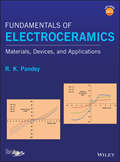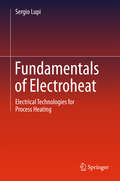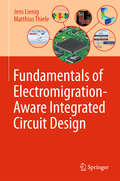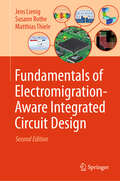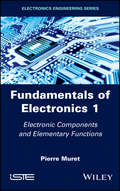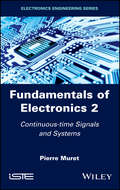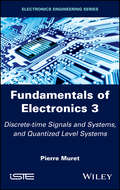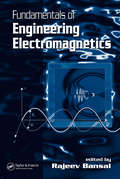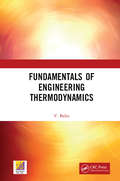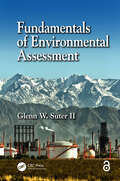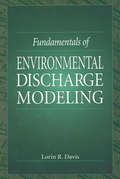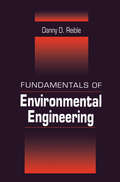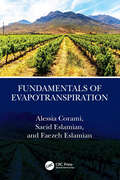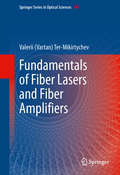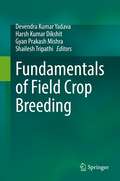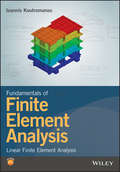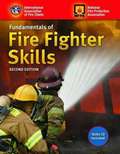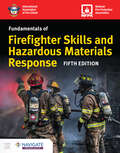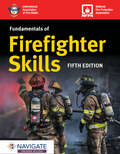- Table View
- List View
Fundamentals of Electroceramics: Materials, Devices, and Applications
by R. K. PandeyThe first textbook to provide in-depth treatment of electroceramics with emphasis on applications in microelectronics, magneto-electronics, spintronics, energy storage and harvesting, sensors and detectors, magnetics, and in electro-optics and acousto-optics Electroceramics is a class of ceramic materials used primarily for their electrical properties. <P><P>This book covers the important topics relevant to this growing field and places great emphasis on devices and applications. It provides sufficient background in theory and mathematics so that readers can gain insight into phenomena that are unique to electroceramics. Each chapter has its own brief introduction with an explanation of how the said content impacts technology. Multiple examples are provided to reinforce the content as well as numerous end-of-chapter problems for students to solve and learn. The book also includes suggestions for advanced study and key words relevant to each chapter. <P><P>Fundamentals of Electroceramics: Materials, Devices and Applications offers eleven chapters covering: 1.Nature and types of solid materials; 2. Processing of Materials; 3. Methods for Materials Characterization; 4. Binding Forces in Solids and Essential Elements of Crystallography; 5. Dominant Forces and Effects in Electroceramics; 6. Coupled Nonlinear Effects in Electroceramics; 7. Elements of Semiconductor; 8. Electroceramic Semiconductor Devices; 9. Electroceramics and Green Energy; 10.Electroceramic Magnetics; and 11. Electro-optics and Acousto-optics. Provides an in-depth treatment of electroceramics with the emphasis on fundamental theoretical concepts, devices, and applications with focus on non-linear dielectrics Emphasizes applications in microelectronics, magneto-electronics, spintronics, energy storage and harvesting, sensors and detectors, magnetics and in electro-optics and acousto-optics Introductory textbook for students to learn and make an impact on technology Motivates students to get interested in research on various aspects of electroceramics at undergraduate and graduate levels leading to a challenging career path. Includes examples and problem questions within every chapter that prepare students well for independent thinking and learning. Fundamentals of Electroceramics: Materials, Devices and Applications is an invaluable academic textbook that will benefit all students, professors, researchers, scientists, engineers, and teachers of ceramic engineering, electrical engineering, applied physics, materials science, and engineering.
Fundamentals of Electroheat
by Sergio LupiThis book provides a comprehensive overview of the main electrical technologies for process heating, which tend to be treated separately in specialized books. Individual chapters focus on heat transfer, electromagnetic fields in electro-technologies, arc furnaces, resistance furnaces, direct resistance heating, induction heating, and high-frequency and microwave heating. The author highlights those topics of greatest relevance to a wide-ranging teaching program, and at the same time offer a detailed review of the main applications of the various technologies. The content represents a synthesis of the extensive knowledge and experience that the author has accumulated while researching and teaching at the University of Padua's Engineering Faculty. This text on industrial electroheating technologies is a valuable resource not only for students of industrial, electrical, chemical, and material science engineering, but also for engineers, technicians and others involved in the application of electroheating and energy-efficient industrial processes.
Fundamentals of Electromigration-Aware Integrated Circuit Design
by Jens Lienig Matthias ThieleThe book provides a comprehensive overview of electromigration and its effects on the reliability of electronic circuits. It introduces the physical process of electromigration, which gives the reader the requisite understanding and knowledge for adopting appropriate counter measures. A comprehensive set of options is presented for modifying the present IC design methodology to prevent electromigration. Finally, the authors show how specific effects can be exploited in present and future technologies to reduce electromigration’s negative impact on circuit reliability.
Fundamentals of Electromigration-Aware Integrated Circuit Design
by Jens Lienig Matthias Thiele Susann RotheThe book provides a comprehensive overview of electromigration and its effects on the reliability of electronic circuits. This second edition has been updated to introduce recent advancements in the understanding of the physical process of electromigration, which gives the reader the knowledge for adopting appropriate counter measures. A comprehensive set of options is presented for modifying the present IC design methodology to prevent electromigration. Finally, the authors show how specific effects can be exploited in present and future technologies to reduce electromigration’s negative impact on circuit reliability.
Fundamentals of Electronic Devices and Circuits (Algorithms for Intelligent Systems)
by G.S. Tomar Ashish BagwariThis book focuses on conceptual frameworks that are helpful in understanding the basics of electronics – what the feedback system is, the principle of an oscillator, the operational working of an amplifier, and other relevant topics. It also provides an overview of the technologies supporting electronic systems, like OP-AMP, transistor, filter, ICs, and diodes. It consists of seven chapters, written in an easy and understandable language, and featuring relevant block diagrams, circuit diagrams, valuable and interesting solved examples, and important test questions. Further, the book includes up-to-date illustrations, exercises, and numerous worked examples to illustrate the theory and to demonstrate their use in practical designs.
Fundamentals of Electronics 1: Electronic Components and Elementary Functions
by Pierre MuretElectronics has undergone important and rapid developments over the last 60 years, which have generated a large range of theoretical and practical notions. This book presents a comprehensive treatise of the evolution of electronics for the reader to grasp both fundamental concepts and the associated practical applications through examples and exercises. This first volume of the Fundamentals of Electronics series comprises four chapters devoted to elementary devices, i.e. diodes, bipolar junction transistors and related devices, field effect transistors and amplifiers, their electrical models and the basic functions they can achieve. Volumes to come will deal with systems in the continuous time regime, the various aspects of sampling signals and systems using analog (A) and digital (D) treatments, quantized level systems, as well as DA and AD converter principles and realizations.
Fundamentals of Electronics 2: Continuous-time Signals and Systems
by Pierre MuretThis book presents a synthesis of Electronics through keynotes which are substantiated in three volumes. The first one comprises four chapters devoted to elementary devices, i.e. diodes, bipolar transistors and related devices, field effect transistors and amplifiers. In each of one, device physics, non linear and linearized models, and applications are studied. The second volume is devoted to systems in the continuous time regime and contains two chapters: one describes different approaches to the transfer function concept and applications, and the following deals with the quadripole properties, filtering and filter synthesis. The third volume presents the various aspects of sampling systems and quantized level systems in the two last chapters.
Fundamentals of Electronics 3: Discrete-time Signals and Systems, and Quantized Level Systems
by Pierre MuretFundamentals of Electronics 3: Discrete-time Signals and Systems, and Quantized Level Systems by Pierre Muret
Fundamentals of Engineering Electromagnetics
by Rajeev BansalElectromagnetics is too important in too many fields for knowledge to be gathered on the fly. A deep understanding gained through structured presentation of concepts and practical problem solving is the best way to approach this important subject. Fundamentals of Engineering Electromagnetics provides such an understanding, distilling the most important theoretical aspects and applying this knowledge to the formulation and solution of real engineering problems.Comprising chapters drawn from the critically acclaimed Handbook of Engineering Electromagnetics, this book supplies a focused treatment that is ideal for specialists in areas such as medicine, communications, and remote sensing who have a need to understand and apply electromagnetic principles, but who are unfamiliar with the field.Here is what the critics have to say about the original work"…accompanied with practical engineering applications and useful illustrations, as well as a good selection of references … those chapters that are devoted to areas that I am less familiar with, but currently have a need to address, have certainly been valuable to me. This book will therefore provide a useful resource for many engineers working in applied electromagnetics, particularly those in the early stages of their careers."-Alastair R. Ruddle, The IEE Online"…a tour of practical electromagnetics written by industry experts … provides an excellent tour of the practical side of electromagnetics … a useful reference for a wide range of electromagnetics problems … a very useful and well-written compendium…"-Alfy Riddle, IEEE Microwave MagazineFundamentals of Engineering Electromagnetics lays the theoretical foundation for solving new and complex engineering problems involving electromagnetics.
Fundamentals of Engineering Plasticity
by William F. HosfordThis book is ideal for those involved in designing sheet metal forming processes. Knowledge of plasticity is essential for the computer simulation of metal forming processes, and understanding the advances in plasticity theory is key to formulating sound analyses. In this book, William Hosford makes the subjects simple by avoiding notations used by specialists in mechanics. R. Hill's authoritative book, Mathematical Theory of Plasticity (1950), presented a comprehensive treatment of continuum plasticity theory up to that time; although much of the treatment in this book covers the same ground, it focuses on more practical topics. Hosford has also included recent developments in continuum theory, including a newer treatment of anisotropy that has resulted from calculations of yielding based on crystallography, analysis of the role of defects, and forming limit diagrams. This text also puts a much greater emphasis on deformation mechanisms, and includes chapters on slip and dislocation theory and twinning.
Fundamentals of Engineering Thermodynamics
by V. BabuThis book deals with all the concepts in first level Thermodynamics course. Numerous examples are given with the objective of illustrating how the concepts are used for the thermodynamic analysis of devices. Please note: T&F does not sell or distribute the Hardback in India, Pakistan, Nepal, Bhutan, Bangladesh and Sri Lanka
Fundamentals of Environmental Assessment
by Glenn W. Suter IIBased on the "go to" book in the field of ecological risk assessment, this shorter, principles-based, updated textbook is essential for students and new practitioners who want to understand the purposes of environmental assessments and how to achieve them. It includes environmental risks to humans as well as nonhuman populations and ecosystems, and most types of environmental assessments. Drawing upon the author’s extensive experience in the field, first as a senior research staff member in the Environmental Sciences Division at Oak Ridge Laboratory and then as science advisor in the United States Environmental Protection Agency’s National Center for Environmental Assessment, the book explains fundamental principles and basic techniques and illustrates them with example applications which carry through multiple chapters and make this book a practical and hands-on guide. Both the content and the style are inviting and approachable to different levels of students.Features Integrates human health and ecological assessments. Includes epidemiological, risk, causal, impact, and outcome assessments. Focuses on fundamental principles that are applicable in all nations and legal contexts. Employs an engaging style and draws on the author’s practical experience. Explains fundamental concepts in short chapters, making it perfect for beginners in the field. Explains the challenges and rewards of a career in environmental assessment. This book is a practical guide for senior and graduate students in environmental sciences and management, as well as new practitioners of assessment who want to understand the purposes of environmental assessments and how to achieve them. The Open Access version of this book, available at www.taylorfrancis.com, has been made available under a Creative Commons Attribution-Non Commercial-No Derivatives (CC-BY-NC-ND) 4.0 license.
Fundamentals of Environmental Discharge Modeling (Mechanical and Aerospace Engineering Series #10)
by Lorin R. DavisThis book examines engineering and mathematical models for documenting and approving mechanical and environmental discharges. The author emphasizes engineering design considerations as well as applications to waste water and atmospheric discharges.Chapters discuss:the fundamentals of turbulent jet mixing, dilution concepts, and mixing zone conceptsdiffuser configurations and head loss calculationsdifferent modeling techniques and accepted models - discussed in detail with theoretical background, restrictions, input, output, and examplesLagrangian and the EPA UM 2-dimensional diffuser modelthe PLUMES interfaceEulerian integral methods, EPA UDKHG 3-dimensional diffuser model, and PDSG surface discharge modelempirical techniques, RSB diffuser model, the CORMIX family of models for both diffusers and surface dischargenumerical methods with a discussion of shelf commercial modelsGaussian atmospheric plume modelsFundamentals of Environmental Discharge Modeling includes numerous case studies and examples for each model and problem.
Fundamentals of Environmental Engineering
by Danny ReibleThe field of environmental engineering is rapidly emerging into a mainstream engineering discipline. For a long time, environmental engineering has suffered from the lack of a well-defined identity. At times, the problems faced by environmental engineers require knowledge in many engineering fields, including chemical, civil, sanitary, and mechanical engineering. Increased demand for undergraduate training in environmental engineering has led to growth in the number of undergraduate programs offered. Fundamentals of Environmental Engineering provides an introductory approach that focuses on the basics of this growing field.This informative reference provides an introduction to environmental pollutants, basic engineering principles, dimensional analysis, physical chemistry, mass, and energy and component balances. It also explains the applications of these ideas to the understanding of key problems in air, water, and soil pollution.
Fundamentals of Environmental Site Assessment and Remediation
by Yue RongFundamentals of Environmental Site Assessment and Remediation examines all aspects of environmental site assessment and remediation and outlines the interdisciplinary skills needed to work in the field. It provides a comprehensive overview for students, environmental professionals, and real estate developers, and includes the latest environmental regulations, environmental site assessment and remediation practices, and industry standards. It examines pollution sources and the related impacts on drinking water supplies, the associated health risks, and how to protect water resources. The monitoring of surface water, groundwater, and soil is explained, as well as vapor intrusion. It will include several practical case studies throughout. Features Includes the latest and best practices for environmental site assessment and remediation procedures. Presents a multidisciplinary approach, including environmental forensics, nanotechnology, microbiology (DNA technology) and isotopes, etc. Examines various pollutants and their related impacts on drinking water supplies, the associated health risks, and how to protect water resources. Presents the best practices for the monitoring of surface water, groundwater, and soil. Covers the latest environmental regulations and industry standards.
Fundamentals of Evapotranspiration
by Saeid Eslamian Faezeh A. Eslamian Alessia CoramiFundamentals of Evapotranspiration aims to determine simple methods to evaluate evapotranspiration and to examine the evolution of these methods over time. It compares and contrasts best practices and discusses the opportunities for harmonization among various methods. Further, the book discusses optimal calibration of these methods in a local context, depending on particular climates and scenarios. The book serves as a practical resource for students and professionals working in agriculture, irrigation and water engineering and will aid in evaluating the methods and equations for the most efficient means of evapotranspiration. The authors examine the methods for evaluating evapotranspiration considering the evaporation from water surfaces, soil and vegetation. The authors address issues according to various regions, climates and soil types, and apply the optimal solution for each situation.
Fundamentals of Fiber Lasers and Fiber Amplifiers
by Valerii Vartan Ter-MikirtychevThis book covers the fundamental aspects of fiber lasers and fiber amplifiers, and includes a wide range of material from laser physics fundamentals to state-of-the-art topics, as well as industrial applications in the rapidly growing field of quantum electronics. Emphasis is placed on the nonlinear processes taking place in fiber lasers and amplifiers, their similarities, differences to, and their advantages over other solid-state lasers. The reader will learn basic principles of solid-state physics and optical spectroscopy of laser active centers in fibers, main operational laser regimes, and practical recommendations and suggestions on fiber laser research, laser applications, and laser product development. The book will be useful for students, researchers, and professionals who work with lasers, in the optical communications, chemical and biological industries.
Fundamentals of Fiber Lasers and Fiber Amplifiers (Springer Series in Optical Sciences #181)
by Vartan V. Ter-MikirtychevThis book covers the fundamental aspects of fiber lasers and fiber amplifiers, and includes a wide range of material from laser physics fundamentals to state-of-the-art topics in this rapidly growing field of quantum electronics. This expanded and updated new edition includes substantial new material on nonlinear frequency conversion and Raman fiber lasers and amplifiers, as well as an expanded list of references inclusive of the recent literature in the field. Emphasis is placed on the nonlinear processes taking place in fiber lasers and amplifiers, their similarities, differences to, and their advantages over other solid-state lasers. The reader will learn the basic principles of solid-state physics and optical spectroscopy of laser active centers in fibers, the main operational laser regimes, and will receive practical recommendations and suggestions on fiber laser research, laser applications, and laser product development. The book will be useful for students, researchers, and professional physicists and engineers who work with lasers in the optical and telecommunications field, as well as those in the chemical and biological industries.
Fundamentals of Fibre Reinforced Composite Materials (Series in Materials Science and Engineering)
by A.R. Bunsell S. Joannès A. ThionnetFibre reinforced composite materials are showing sustained growth in an ever widening range of applications from food trays to spacecraft as well as contributing to resolving environmental problems, including enabling the forthcoming hydrogen economy to be realised. This second edition of Fundamentals of Fibre Reinforced Composite Materials has been fully updated throughout, providing an authoritative and modern introduction to the topic with a brief history of composite development, a review of composite applications, manufacture and markets, types of fibres and matrices used, and their properties with a detailed introduction into the computer simulation of composite behaviour. With extensive sets of sample problems accompanying each chapter, this book is ideally suited to undergraduate and graduate students of materials science, structural, mechanical, and aeronautical engineering, polymer science, metallurgy, and other courses. It will also be of use as a reference to researchers and engineers working with composite materials and material scientists in general. Features: Presents thorough discussions on composite history, composite applications and markets, types of fibres and resins used, and their respective properties Relates mathematical concepts to the structure of the material under discussion leading to the quantitative evaluation of safety factors Provides numerous sets of sample problems in each chapter
Fundamentals of Fibre-Reinforced Soil Engineering
by Sanjay Kumar ShuklaThis book is intended to serve as a one-stop reference on fibre-reinforced soils. Over the past 30-35 years, the engineering behaviour of randomly distributed/oriented fibre-reinforced soil, also called simply fibre-reinforced soil, has been investigated in detail by researchers and engineers worldwide. Waste fibres (plastic waste fibres, old tyre fibres, etc. ) create disposal and environmental problems. Utilization of such fibres in construction can help resolve these concerns. Research studies and some field applications have shown that the fibres can be utilized in large quantities in geotechnical and civil engineering applications in a cost-effective and environmentally friendly manner. This book covers a complete description of fibres, their effects when included within a soil or other similar materials such as the fly ash, and their field applications. It gives a detailed view of fibre-reinforced soil engineering. The book will be useful to students, professional, and researchers alike, and can also serve as a text for graduate coursework and professional development programs
Fundamentals of Field Crop Breeding
by Harsh Kumar Dikshit Gyan Prakash Mishra Devendra Kumar Yadava Shailesh TripathiThis book is an advanced textbook and a reference book for the post-graduate plant-breeding students and the plant breeders. It consolidates fundamental concepts and also the latest advances in plant-breeding practices including development in crop genomics. It contains crop wise explanation on origin, reproduction, genetics of yield contributing traits, biotic and abiotic stresses, nutritional improvement and crop specific plant-breeding procedures and techniques. The chapters are planned to describe crop-focused breeding procedure for the major crop plants as per their economic importance. The recent developments in breeding of field crops have been reported. The recent progress made in mapping traits of economic importance has been critically reviewed for each crop. The progress made in markers assisted selected in few crops has been summarized. This book bridges the knowledge gap and bring to the researchers and students information on modern breeding tools for developing biotic and abiotic stress tolerant, climate resilient and micronutrient rich varieties of field crops. The chapters in book are contributed by experienced Plant Breeders.
Fundamentals of Finite Element Analysis: Linear Finite Element Analysis
by Ioannis KoutromanosAn introductory textbook covering the fundamentals of linear finite element analysis (FEA) This book constitutes the first volume in a two-volume set that introduces readers to the theoretical foundations and the implementation of the finite element method (FEM). The first volume focuses on the use of the method for linear problems. A general procedure is presented for the finite element analysis (FEA) of a physical problem, where the goal is to specify the values of a field function. First, the strong form of the problem (governing differential equations and boundary conditions) is formulated. Subsequently, a weak form of the governing equations is established. Finally, a finite element approximation is introduced, transforming the weak form into a system of equations where the only unknowns are nodal values of the field function. The procedure is applied to one-dimensional elasticity and heat conduction, multi-dimensional steady-state scalar field problems (heat conduction, chemical diffusion, flow in porous media), multi-dimensional elasticity and structural mechanics (beams/shells), as well as time-dependent (dynamic) scalar field problems, elastodynamics and structural dynamics. Important concepts for finite element computations, such as isoparametric elements for multi-dimensional analysis and Gaussian quadrature for numerical evaluation of integrals, are presented and explained. Practical aspects of FEA and advanced topics, such as reduced integration procedures, mixed finite elements and verification and validation of the FEM are also discussed. Provides detailed derivations of finite element equations for a variety of problems. Incorporates quantitative examples on one-dimensional and multi-dimensional FEA. Provides an overview of multi-dimensional linear elasticity (definition of stress and strain tensors, coordinate transformation rules, stress-strain relation and material symmetry) before presenting the pertinent FEA procedures. Discusses practical and advanced aspects of FEA, such as treatment of constraints, locking, reduced integration, hourglass control, and multi-field (mixed) formulations. Includes chapters on transient (step-by-step) solution schemes for time-dependent scalar field problems and elastodynamics/structural dynamics. Contains a chapter dedicated to verification and validation for the FEM and another chapter dedicated to solution of linear systems of equations and to introductory notions of parallel computing. Includes appendices with a review of matrix algebra and overview of matrix analysis of discrete systems. Accompanied by a website hosting an open-source finite element program for linear elasticity and heat conduction, together with a user tutorial. Fundamentals of Finite Element Analysis: Linear Finite Element Analysis is an ideal text for undergraduate and graduate students in civil, aerospace and mechanical engineering, finite element software vendors, as well as practicing engineers and anybody with an interest in linear finite element analysis.
Fundamentals of Fire Fighter Skills (Second Edition)
by National Fire Protection Association Staff International Association of Fire Chiefs StaffLearn more of the fundamental skills necessary to be a successful fire fighter.
Fundamentals of Firefighter Skills and Hazardous Materials Response Includes Navigate Premier Access
by IafcFundamentals of Firefighter Skills with Hazardous Materials Response, Fifth Edition with Navigate Premier Access is the complete teaching and learning solution for Firefighter I and Firefighter II with Hazardous Materials Response courses.
Fundamentals of Firefighter Skills with Navigate Premier Access
by IafcFundamentals of Firefighter Skills, Fifth Edition with Navigate Premier Access is the complete teaching and learning solution for Firefighter I and Firefighter II courses.
